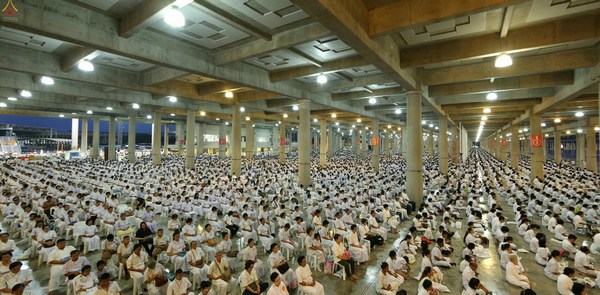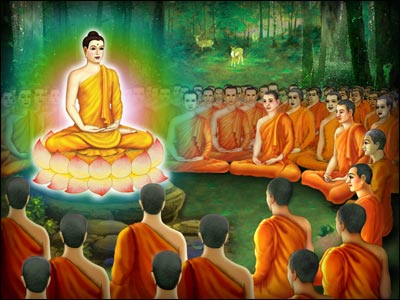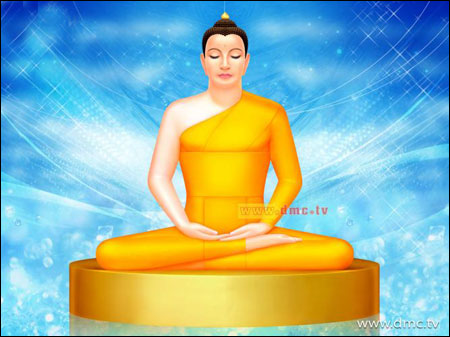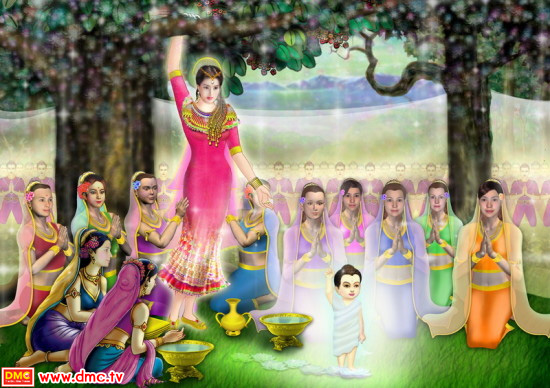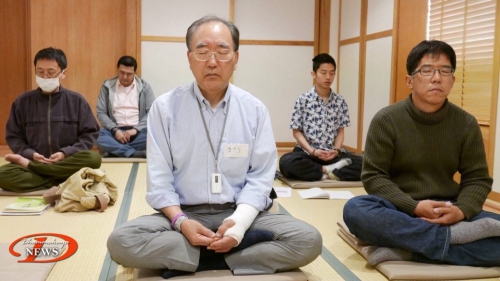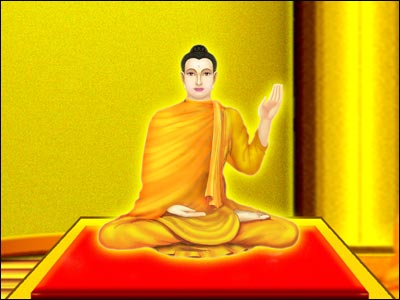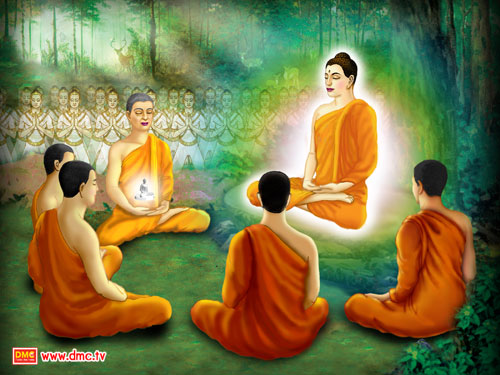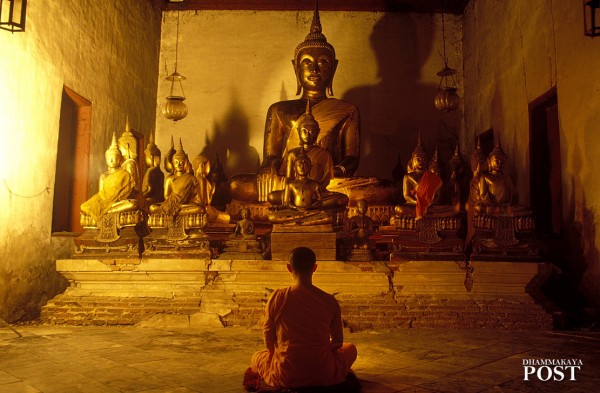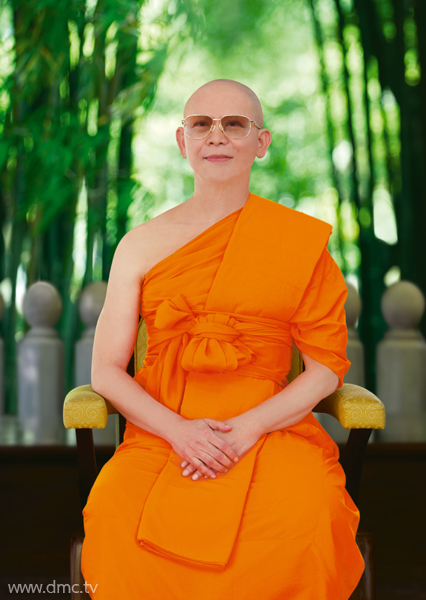Dhammacakkappavattana Sutta
(บทธัมมจักกัปปวัตตนสูตร ภาษาอังกฤษ)
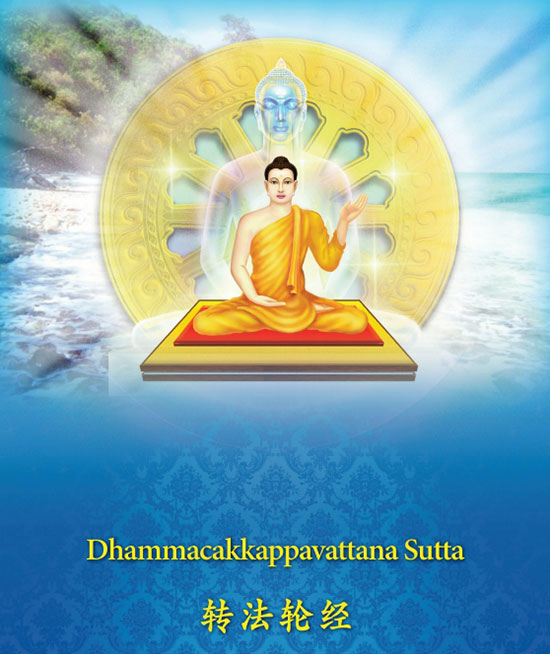
Introduction
How long are you willing to wait until you get to do what you love to do the most? 20 years? Entire life? Or, more than a lifetime?
In Lord Buddha’s case, he waited billions of lifetimes before his greatest wish came true. “Dhammacakkappavattana Sutta,” which recounts the historic event in which the Buddha gave his first-ever sermon, might take less than 20 minutes to chant but it was a culmination of the world’s longest-running story of love for humanity.
Buddhism was founded out of unconditional love. When we love someone, not only we wish that person happy but also we try to do whatever we can to bring happiness to that person. In so doing, we give, share and make sacrifices. That exactly what Gautama Buddha did unconditionally.
After painstakingly risking his own life, he shared all the knowledge that he discovered out of a sheer wish to help fellow human beings free themselves from the bondage of physical and emotional suffering without expecting anything
in return except their happiness.
Prior to becoming a Buddha in his final lifetime, he endured and embraced many physical and emotional challenges as he sought to accrue virtue and develop Buddha-like qualities. During those billions of lifetimes while he was still a Bodhisattava, he purposely endured the pains of birth and rebirth, of aging, sickness and death, sacrificing his worldly power, wealth, flesh, blood, and even his life all for the attainment of Buddhahood.
The Middle Way
The Buddha’s first sermon following his Enlightenment is his love code for humanity: the best way to love oneself and fellow human beings. That best way is embodied in the Middle Way. While we might have heard the term many times before, the concept was considered revolutionary in the Buddha’s times. In those days there were two prominent schools of thought that drew huge numbers of followers: one believed in sensual indulgence and the other believed in self-mortification as the means to achieving supreme happiness and spiritual liberation.
Born as a prince of the Shakyamuni dynasty, Siddhārtha Gautama lived in extreme luxury and sensual comfort. So, he knew material-based, sensual indulgence was not the way. Then, at 29 he decided to leave his palace and spent six years practicing self-mortification to the point where he lost much of his weight and muscles, fainted, and almost died. So, he knew that was not the way either. In the end, he discovered the way to bring his mind to a complete standstill and all the answers that he had been looking for began to pour from the inside.
When the Buddha delivered his debut sermon, he spelt clear that the right and only way towards total spiritual liberation, freedom from suffering, and eternal happiness is the Middle Way, and that it starts from within – not outside oneself like what those two schools of thought advocated. Citing himself as an example, the Buddha told a group of five ascetics, who used to practice self-mortification with him, that the Middle Way was how he transformed himself from ascetic Siddhārtha to the world’s first Arahant.
This point bears stressing. Ascetic Siddhārtha did not achieve complete Enlightenment through reading Dhamma books, analyzing other people’s teachings, undertaking scholarly studies, or engaging in intellectual discussions. In other words, he did not think his way to Nibbāna – and nor could we. He achieved complete Enlightenment through meditation, which requires no thinking. This means, if we want to achieve Enlightenment like the Buddha did – even partially – we need to meditate.
This doesn’t mean any kind of meditation will do. Prior to becoming a Buddha, he and the five ascetics also practiced meditation but it was not the right kind. The right kind of meditation – under which there are several techniques to choose from - is one that brings the mind back to the center of the body. Located exactly at the middle of one’s body horizontally and vertically (around the middle of one’s stomach or two fingers-width above the navel to be exact), the center of the body is the natural home of the human mind where it feels most blissful.
In the words of the late Meditation Master Phra Mongkolthepmuni (Sodh Candasaro), who rediscovered and brought back to the world the Buddha’s long lost knowledge about the Dhammakaya or Body of Enlightenment, the center of the body is where one’s Middle Way journey begins. To experience the Middle Way firsthand, it is necessary to bring the mind to a standstill. At which point, we will experience the infinite ocean of joy that lies within. It is all right to use the brain to study and reflect upon the Buddha’s teachings. However, when it comes to training and purifying the mind, we need to meditate.
The Middle Way works from the inside out as well as from the outside in. In action terms, it means if we wish to meditate better, it is necessary for us to observe precepts (five or eight precepts for lay people) and practice Dāna (such as donating blood to a hospital, giving aid to natural disaster victims, volunteering in charitable work, forgiving, giving up anger, giving up hatred, offering emotional support to a friend who tries to do good but is misunderstood, offering sustenance to monks, spreading loving kindness, being kind to people without expecting anything in return, and so on).
Here’s a takeaway lesson. When we practice being gentle in our words and actions, we grow gentility on the inside as well. The more we practice thinking clean thoughts, speaking clean words, and keeping things around us clean, the easier it will be for us to clean our minds. To summarize, the more we embody the essence of Buddhahood, the closer we are to Nibbāna. The Buddha embodies unconditional love, which is compassion without attachment. Therefore, when in doubt about what to say, do or not do at all, ask yourself what the Buddha would do in this situation.
The Backbone of Buddha’s Teachings
Dhammacakkappavattana Sutta is the Buddha’s most important discourse as it led to the birth of Buddhism. It is the backbone of Dhamma upon which all the 84,000 units of the Buddha’s teachings are based. The moment the Buddha delivered his debut sermon to the five ascetics on a full-moon day in the Isipatana Deer Park, the Dhamma came into existence.
One of the ascetics, Koṇḍhañña, achieved the first level of Enlightenment while listening to this sermon and meditating. The Buddha then granted him permission to be ordained as a Buddhist monk, and the Sangkha came into existence. Hence, the debut sermon was given the Pāli name Dhammacakkappa vattana Sutta, meaning “The Discourse That Sets Turning the Wheel of Truths” as it marks the start of promulgation of Buddhism. When the Triple Gem (the Buddha, the Dhamma and the Sangkha) emerged, Buddhism was founded. That historic day came to be known as “Asanha Bucha Day”.
Because the discourse largely contains names of key Dhamma concepts, it can be difficult to comprehend. Written in the times when there were no typewriters or computers, it was a lyrical record of the historic event leading to the establishment of Buddhism, which rejoiced deities in all the six classes of Heaven (Cātummahārājikā, Tāvatiṃsā, Yāmā, Tusitā, Nimmānaratī, and Paranimmitavasavattī). It was not meant to expound the Buddha’s first teaching but to recapitulate the core concepts that form the backbone of Buddhism, namely: the Middle Way, the Eightfold Path, and the Four Noble Truths. All these concepts require meditation practice for delving beyond intellectual comprehension.
The Buddha particularly chose the five ascetics as the audience of his first sermon because he knew that they had been well prepared. By that time, they had already accrued enough wisdom, underwent sufficient mind training, and developed many virtuous qualities millions of lifetimes before. The fact that all of them achieved full Enlightenment after the Buddha gave his second discourse (Anattalakkhaṇa Sutta) just days later proved that they were in deed the right audience who could help him spread Buddhism for the benefit of humankind. For the rest of us, we need further detailed explanation and examples, which cannot possibly be covered in this booklet.
Dhammacakkappavattana Sutta is based on the recitation of the historic event as recounted by Ananda Bhikkhu, attendant of Gautama Buddha. Thus, the name of this enlightened monk appears at the beginning of this Sutta. Immediately after his Enlightenment, the Buddha spent seven weeks in reclusive meditation retreat under the Bodhi tree. At the close of this period, he decided to proclaim the Dhamma that he had discovered. He then left the city of Gaya, where he attained Enlightenment, for the Isipatana Deer Park (known today as Sarnath). Knowing that the five ascetics were still vigorously practicing stoicism, the Buddha shared his discovery with them and showed them the right way towards Enlightenment.
Benefits of Chanting the Sutta
As we chant and recall the magical moment in which the Buddha forever changed the world, we also change our state of mind. The holy passages contained in this Sutta have the power to soothe, cleanse and ready the mind for meditation.
Because we become what we think about, we are spiritually one with the Buddha as we chant the Sutta with respect, concentration and appreciation for all his unconditional love and sacrifices. As you chant this lyrical love code, you experience a Buddha’s moment, connect with your highest self, and water the seed of Enlightenment within you.
Besides calming mental clatters and bringing peace to your mind, each chanting serves to remind that you too can unchain yourself from the shackles of misery. You too can discover the Buddha within you. You too can be enlightened. Since that full-moon day in the Isipatana Deer Park near the City of Benares of northern India over 2,600 years ago, millions have successfully journeyed through the Middle Way, and so can you.
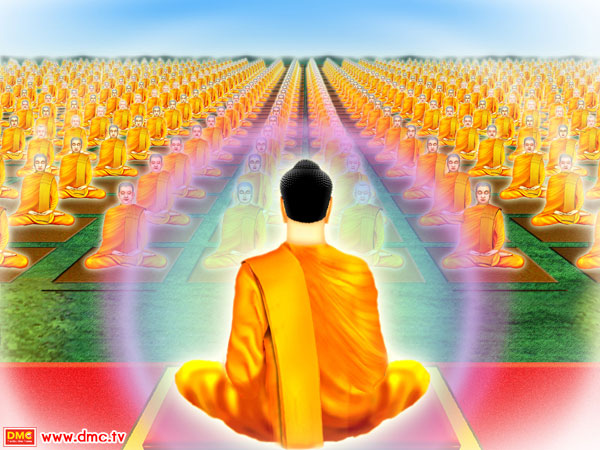
Dhammacakkappavattana Sutta (leader)
Ah-noot Ta-rung Ah-pi-sum Pōe-ting Sum-put Chi-ta-va Ta-thā Ka-tōe
Pa-tha-mung Young Ah-tay Say-si Tum-ma Juk-gung Ah-noot Ta-rung
Sum-ma Tay-va Pa-wat Tēn-tōe Lo-gay Up-pa Thi-wat Ti-young
Yat-thāk Khā-tā U-pō Un-tā Pa-ti Pāt-ti Ja Mud-chi-mā
Ja-tū Sa-vā Ri-ya-saj Jay-su Vi-soot-tung Yā-na Tus-sa-nung
Tay-si-tung Tum-ma-ra Chay-na Sum-mā Sum-pōe-thi Kit-ta-nung
Nā-may-na Vis-su-tung Soot-tung Tum-ma-juk Gup-pa-vat Ta-nung
Vai-yā Ga-ra-na-pā Tay-na Sung-key Ton-tum Pa-nā Ma-say.
Dhammacakkappavattana Sutta (all)
A-vum-may Su-tung (Follow>>)
A-gung Sa-ma-young Pa-ka-wa Pa-ra-na-si-young
Vi-ha-ra-ti I-si-pa-ta-nay Mi-ka-thā-yay Tut-ra-khō Pa-ka-wa
Pun-ja Vuck-ki-yay Pick-khū Ah-mon Tay-si.
Ta-way-may Pick-kha-way Un-tā Pup-pa Chi-thay Na-na
Say-vi Tup-pa Yō Jā-young Gā-may-su Gā-ma-su-khal Li-ghā
Nu-yō-ko He-nō Gum-mō Pōe-tooj Cha-ni-gō Ah-na-ri-yō
Ah-nut Tha-sun Hī-tōe Yō-jā-young Ut-ta Ki-la-ma-thā
Nu-yō-kō Thook-khō Ah-na-ri-yō Ah-nut Tha-sun Hī-thōe.
A-thay Thay Pick-kha-way U-pō Un-thay Ah-nu-pa-kum
Ma-mud Chi-mā Pa-ti Pa-thā Ta-thā Ka-thay Na Ah-pi-sum
Put-thā Juk-khū Ga-ra-nee Yā-na Ga-ra-nee U-pa-sa-mā Ya
Ah-pin Yā-ya Sum-pōe Thā-ya Nib-paā Nā-ya Sung-wat
Ta-tī.
Ga-ta-ma Ja Sā Pick-Kha-way Mud-chi-mā Pa-ti Pa-thā
Ta-thā Ka-thay Na Ah-pi-sum Put-thā Juk-khū Ga-ra-nee
Yā-na Ga-ra-nee U-pa-sa-mā Ya Ah-pin Yā-ya Sum-pōe
Thā-ya Nib-paā Nā-ya Sung-wat Ta-tī.
Ah-yā-may Va Ah-ri-yō Ut-tung Ki-gō Muk-kō Sai-ya
Thī-tung. Sum-mā Thid-thi Sum-mā Sung-gup-pō Sum-mā
Vā-jā Sum-mā Gum-mon-tōe Sum-mā Ar-chee-vō Sum-mā
Vā-yā-mō Sum-mā Sa-ti Sum-mā Sa-mā-thi.
Ah-young Khō Sā Pick-kha-way Mud-chi-mā Pa-ti Pa-thā
Ta-thā Ka-thay Na Ah-pi-sum Put-thā Juk-khū Ga-ra-nee
Yā-na Ga-ra-nee U-pa-sa-mā Ya Ah-pin Yā-ya Sum-pōe
Thā-ya Nib-paā Nā-ya Sung-wat Ta-tī.
Ey-tung Khō Pa-na Pick-kha-way Thook-khung
Ah-ri-ya Saj-jung. Cha-ti-pi Thook-khā Cha-rā-pi Thook-khā
Ma-ra-num Pi-thook-khung Sōe-gha Pa-ri-tay-va
Thook-Kha-thōe Ma-nus Su-pā-yā Sā-pi Thook-khā Up
Pi-yay-hi Sum-pa Yō-kō Thook-Khō Pi-yay-hi Vip Pa-yō-kō
Thook-khō Yum-pij-chung Na-la-pa Ti-tum Pi-thook-khung
Sung-khid Thay-na Pun-ju Pā-thā Nuk-kun-thā Thook-khā.
Ey-tung Khō Pa-na Pick-kha-way Thook-kha Sa-mu-tha-yō
Ah-ri-ya Saj-jung. Yā-young Ton-hā Pōe-nō Pa-vi-ghā Nun
Thi-ra-ka Sa-ha-ka-tā Tut-ra-tut Trā Pi-nun Thi-nee. Sai-ya
Thī-tung. Gā-ma Ton-hā Pa-va Ton-hā Vi-pa-va Ton-hā.
Ey-tung Khō Pa-na Pick-kha-way Thook-kha Ni-rō-thōe
Ah-ri-ya Saj-jung. Yo Tus-sā Yay-va Ton-hā-ya Ah-say-sa
Vi-ra-ka Ni-rō-thōe Jā-kō Pā-thi Nis Sūk-kō Moot-ti Ah-nā
La-yō.
Ey-tung Khō Pa-na Pick-kha-way Thook-kha Ni-rō Tha-kā
Mi-nee Pa-ti Pa-thā Ah-ri-ya Saj-jung. Ah-yā-may Va Ah-ri-yō
Ut-tung Ki-gō Muk-kō Sai-ya Thī-tung Sum-mā Thid-thi
Sum-mā Sung-gup-pō Sum-mā Vā-jā Sum-mā Gum-mon-tōe
Sum-mā Ar-chee-vō Sum-mā Vā-yā-mō Sum-mā Sa-ti
Sum-mā Sa-mā-thi.
(PAUSE)
Ey-tung Thook-khung (Follow>>) Ah-ri-ya Saj-jun Ti-may
Pick-kha-way Pūp-pay Ah-na-noose Su-thay Su-tum-may
Su-juk-khoong U-tha-pā-thi Yā-nung U-tha-pā-thi Pun-yā
U-tha-pā-thi Vij-chā U-tha-pā-thi Ar-lō-gō U-tha-pā-thi.
Tung-khō Pa-ni-tung Thook-khung Ah-ri-ya Saj-jung
Pa-rin Yai-yun Ti-may Pick-kha-way Pūp-pay Ah-na-noose
Su-thay Su-tum-may Su-juk-khoong U-tha-pā-thi Yā-nung
U-tha-pā-thi Pun-yā U-tha-pā-thi Vij-chā U-tha-pā-thi
Ar-lō-gō U-tha-pā-thi.
Tung-khō Pa-ni-tung Thook-khung Ah-ri-ya Saj-jung
Pa-rin-yā Ton-ti-may Pick-kha-way Pūp-pay Ah-na-noose
Su-thay Su-tum-may Su-juk-khoong U-tha-pā-thi Yā-nung
U-tha-pā-thi Pun-yā U-tha-pā-thi Vij-chā U-tha-pā-thi
Ar-lō-gō U-tha-pā-thi.
Ey-tung Thook-kha Sa-moot-tha-yō Ah-ri-ya Saj-jun
Ti-may Pick-kha-way Pūp-pay Ah-na-noose Su-thay
Su-tum-may Su-juk-khoong U-tha-pā-thi Yā-nung
U-tha-pā-thi Pun-yā U-tha-pā-thi Vij-chā U-tha-pā-thi
Ar-lō-gō U-tha-pā-thi.
Tung-khō Pa-ni-tung Thook-kha Sa-moot-tha-yō
Ah-ri-ya Saj-jung Pa-haā Tup-pun Ti-may Pick-kha-way
Pūp-pay Ah-na-noose Su-thay Su-tum-may Su-juk-khoong
U-tha-pā-thi Yā-nung U-tha-pā-thi Pun-yā U-tha-pā-thi
Vij-chā U-tha-pā-thi Ar-lō-gō U-tha-pā-thi.
Tung-khō Pani-tung Thook-kha Sa-moot-tha-yō
Ah-ri-ya Saj-jung Pa-he-nun Ti-may Pick-kha-way Pūp-pay
Ah-na-noose Su-thay Su-tum-may Su-juk-khoong
U-tha-pā-thi Yā-nung U-tha-pā-thi Pun-yā U-tha-pā-thi
Vij-chā U-tha-pā-thi Ar-lō-gō U-tha-pā-thi.
Ey-tung Thook-kha Ni-rō-thōe Ah-ri-ya Saj-jun Ti-may
Pick-kha-way Pūp-pay Ah-na-noose Su-thay Su-tum-may
Su-juk-khoong U-tha-pā-thi Yā-nung U-tha-pā-thi Pun-yā
U-tha-pā-thi Vij-chā U-tha-pā-thi Ar-lō-gō U-tha-pā-thi.
Tung-khō Pa-ni-tung Thook-kha Ni-rō-thōe Ah-ri-ya
Saj-jung Saj-chi-gaā Tup-pun Ti-may Pick-kha-way
Pūp-pay Ah-na-noose Su-thay Su-tum-may Su-juk-khoong
U-tha-pā-thi Yā-nung U-tha-pā-thi Pun-yā U-tha-pā-thi
Vij-chā U-tha-pā-thi Ar-lō-gō U-tha-pā-thi.
Tung-khō Pa-ni-tung Thook-kha Ni-rō-thoe
Ah-ri-ya Saj-jung Saj-chi Ga-ton Ti-may Pick-kha-way
Pūp-pay Ah-na-noose Su-thay Su-tum-may Su-juk-khoong
U-tha-pā-thi Yā-nung U-tha-pā-thi Pun-yā U-tha-pā-thi
Vij-chā U-tha-pā-thi Ar-lō-gō U-tha-pā-thi.
Ey-tung Thook-kha Ni-rō Tha-ka Mi-nee Pa-ti Pa-thā
Ah-ri-ya Saj-jun Ti-may Pick-kha-way Pūp-pay Ah-na-noose
Su-thay Su-tum-may Su-juk-khoong U-tha-pā-thi Yā-nung
U-tha-pā-thi Pun-yā U-tha-pā-thi Vij-chā U-tha-pā-thi
Ar-lō-gō U-tha-pā-thi.
Tung-khō Pa-ni-tung Thook-kha Ni-rō Tha-ka Mi-nee
Pa-ti Pa-thā Ah-ri-ya Saj-jung Paā-way Tup-pun Ti-may
Pick-kha-way Pūp-pay Ah-na-noose Su-thay Su-tum-may
Su-juk-khoong U-tha-pā-thi Yā-nung U-tha-pā-thi Pun-yā
U-tha-pā-thi Vij-chā U-tha-pā-thi Ar-lō-gō U-tha-pā-thi.
Tung-khō Pa-ni-tung Thook-kha Ni-rō Tha-ka Mi-nee
Pa-ti Pa-thā Ah-ri-ya Saj-jung Paā-vi-ton Ti-may Pick-kha-way
Pūp-pay Ah-na-noose Su-thay Su-tum-may Su-juk-khoong
U-tha-pā-thi Yā-nung U-tha-pā-thi Pun-yā U-tha-pā-thi
Vij-chā U-tha-pā-thi Ar-lō-gō U-tha-pā-thi.
Ya-wa Guee-won Ja-may Pick-kha-way Ey-may-su
Ja-tu-su Ah-ri-ya-saj Jay-su A-won Ti-pa-ri-wat Tung Tha-wa
Ta-sa Ka-rung Ya-tha Pū-tung Yā-na Tus-sa-nung Na
Su-vi-soot-thung Ah-hō-sī.
Nay-wa Tā-waā-hung Pick-kha-way Sa-tay Wa-gay
Lo-gay Sa-ma Ra-gay Sa-prum Ma-gay Sus-sa Ma-na
Prum-ma-ni-ya Pa-cha-ya Sa-tay-wa Ma-noose Sa-ya
Ah-noot Ta-rung Sum-mā Sum-pōe-thing Ah-pi-sum
Put-thōe Paj-jun Ya-singh
Ya-tōe Ja-khō May Pick-kha-way Ey-may-su Ja-tu-su
Ah-ri-ya-saj Jay-su A-won-ti Pa-ri-wat-tung Ta-wa Ta-sa
Ka-rung Ya-thā Pū-tung Yāna Tus-sa-nung Su-vi-soot-thung
Ah-hō-si.
Ah-thā-hung Pick-kha-way Sa-tay Wa-gay Lo-gay Sa-ma
Ra-gay Sa-prum Ma-gay Sus-sa Ma-na Prum-ma-ni-ya
Pa-cha-ya Sa-tay-wa Ma-noose Sa-ya Ah-noot Ta-rung
Sum-mā Sum-pōe-thing Ah-pi-sum Put-thōe Paj-jun
Ya-singh
Yā-nun-ja Pa-na May Tus-sa-nung U-tha Pā-thi
Ah-koop-pa May Vi-moot-ti Ah-ya-mon Ti-ma Cha-ti Nut-thi
Tha-ni Pu-nup Pa-vo-ti
Ey-tha-ma-vō Ja-pa-ka-vā. Ut-ta-ma-nā Pun-ja-vuk Ki-yā
Pick-khū Pa-ka-va-tōe Pā-si-tung Ah-pi Nun-toong.
Ey-mus Sa-min Ja Pa-na Wai-yā Ga-ra-nus-ming Pun-ya
Mā-nay Ar-yus-sa Ma-thōe Gō-tun Yus-sā Vi-ra-chung
We-ta-ma-lung Tum-ma Juk-koong U-tha Pā-thi Young
Kin-ji Sa-mu-tha-ya Tum-mung Sub-pun-tung Ni-rō-tha
Tum-mon-ti.
Pa-wat Ti-thay Ja-pa-ka-wa-tā Tum-ma Juk-gay Poom-ma
Tay-va Sūt-ta Ma-noose Sā-way-soong A-tum Puck-ka-wa-ta
Pa-ra-na-si-young I-si-pa-ta-nay Mi-ka-thā-yay Ah-noot
Ta-rung Tum-ma Juk-gung Pa-wat Ti-tung Up-pa Ti-wat
Ti-young Sa-ma-nay Na-wa Prum-ma-nay Na-wa Tay-way
Na-wa Ma-ray Na-wa Prum-mu-na Wa Gay-na-ji-vā Lō Gus
Min....Ti.
(PAUSE)
Poom-mā-nung (Follow>>) Tay-va-nung Sūt-tung
Soot-ta-va Jā-toom Ma-ha Ra-chi-ka Tay-va Sūt-ta Ma-noose
Sa-way-soong
Jā-toom Ma-ha Ra-chi-ka-nung Tay-va-nung Sūt-tung
Soot-ta-wa Ta-va-ting-sa Tay-va Sūt-ta Ma-noose
Sā-way-soong
Ta-wa-ting-sa-nung Tay-va-nung Sūt-tung Soot-ta-wa
Ya-ma Tay-va Sūt-ta Ma-noose Sā-way-soong
Ya-ma-nung Tay-va-nung Sūt-tung Soot-ta-wa Tu-si-tā
Tay-va Sūt-ta Ma-noose Sā-way-soong
Tu-si-tā-nung Tay-va-nung Sūt-tung Soot-ta-wa
Nim-ma-na-ra-tee Tay-va Sūt-ta Ma-noose Sā-way-soong
Nim-ma-na-ra-tee-nung Tay-va-nung Sūt-tung
Soot-ta-wa Pa-ra-nim Mi-ta-va Sa-wat-tee Tay-va Sūt-ta
Ma-noose Sā-way-soong
Pa-ra-nim Mi-ta-va Sa-wat-tee-nung Tay-va-nung
Sūt-tung Soot-ta-wa Prum-ma-ka-yi-ka Tay-va Sūt-ta
Ma-noose Sā-way-soong
A-tum Puck-ka-wa-ta Pa-ra-na-si-young I-si-pa-ta-nay
Mi-ka-thā-yay Ah-noot Ta-rung Tum-ma Juk-gung
Pa-wat Ti-tung Up-pa Ti-wat Ti-young Sa-ma-nay Na-wa
Prum-ma-nay Na-wa Tay-way Na-wa Ma-ray Na-wa
Prum-mu-na Wa Gay-na-ji-vā Lō Gus Min...Ti.
(PAUSE)
Ey-ti-ha-thay-na (Follow>>) Ka-nay-na Thay-na
Mu-hoot Thay-na Ya-wa Prum-ma-lō-gā Sūt-tōe Up-pūk
Kuj-chi
Ah-yun-ja Ta-sa Sa-hus-sri Lo-ga Tha-tu Sung-gum-pi
Sum-pa Gum-pi Sum-pa Way-thi Up-pa Ma-no Ja O-lār-lo
O-pā-sōe Lo-gay Pa-tu Ra-hō-si Ah-tik Gum-may-va
Tay-va-nung Tay-va Nu-pā-vung
Ah-tha-khō Puck-ka-wa U-thā-nung U-thā Nay-si
Un-ya-si Va-ta-pōe Go-tun-yo Un-ya-si Va-ta-pōe Go-tun
Yo-ti Ey-ti Hī-thung Ah-yus Sa-ma-thōe Go-tun-yus-sa
“Un-ya Go-tun-yo” Ta-way-wa Na Mung Ah-hō See…Ti.
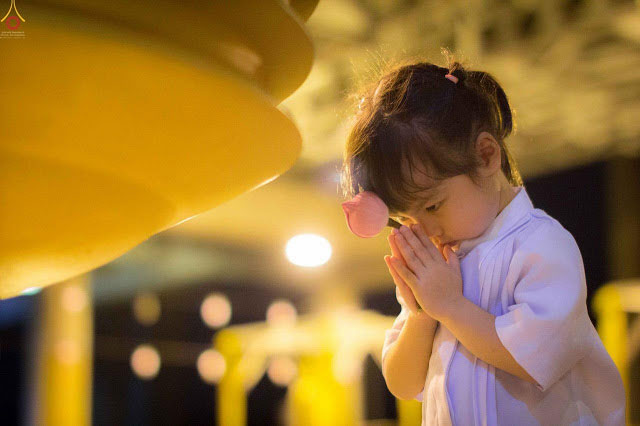
Dhammacakkappavattana Sutta (leader)
Following his Enlightenment, the Buddha went on to proclaim the Dhamma he had discovered, which is superior to all the knowledge in the world. He advised all to steer clear from the paths of two extremes, namely sensual indulgence and self-mortification. He declared the Middle Way as the path towards the irreversible end of suffering and rebirth. He pointed out the Four Noble Truths and the Noble Eightfold Path that lead to Enlightenment. In homage of the Buddha, let us chant Dhammacakkappa vattana Sutta, which was composed in Pali language by learned monks of ancient times, to recall the first teaching of the Blessed One.
Dhammacakkappavattana Sutta (all)
in original Pali with translations
Evaṃ me sutaṃ, Ekaṃ samayaṃ Bhagavā Bārāṇasiyaṃ
viharati isipatane migadāye. Tatra kho Bhagavā pañcavaggiye
bhikkhū āmantesi
I (Ānanda Bhikkhu) have heard that once the Buddha
was at the Isipatana Deer Park near the City of Benares,
and gave a sermon to a group of five ascetics.
Dveme, bhikkhave, antā pabbajitena na sevitabbā
There are two extreme paths that those seeking
Enlightenment should stay away from.
Yo cāyaṃ kāmesu kāmasukhallikānuyogo Hīno gammo
pothujjaniko anariyo anatthasañhito,
One is the path of indulgence in material-based,
sensual pleasure. Such engagement fuels worldly desires,
induces attachment, and pollutes the mind. It is harmful,
useless, and thus not the way of the Enlightened.
Yo cāyaṃ attakilamathānuyogo dukkho anariyo
anatthasañhito.
Another is the path of self-mortification. Such is
afflicting pain upon oneself. It is harmful and useless for
defeating the enemies within (“Kilesa” or defilements).
The Middle Way
Ete te, bhikkhave, ubho ante anupagamma Majjhimā
paṭipadā tathāgatena abhisambuddhā Cakkhukaraṇī
ñāṇakaraṇī Upasamāya abhiññāya sambodhāya nibbānāya
saṃvattati
Steer clear of these two paths. Instead, follow the
Middle Way in which the Buddha discovered through
Enlightened wisdom for it leads to victory over the devils
within, the end of ignorance, and complete freedom from
suffering.
Katamā ca sā, bhikkhave, majjhimā paṭipadā
Tathāgatena abhisambuddhā Cakkhukaraṇī ñāṇakaraṇī
Upasamāya abhiññāya sambodhāya nibbānāya saṃvattati
What then is the Middle Way that the Buddha
discovered? It is the path that activates inner vision, leading
to Enlightened wisdom, total awakening, and triumph over
Kilesa the inner foes.
The Noble Eightfold Path
Ayameva ariyo aṭṭhaṅgiko maggo,
Seyyathidaṃ sammādiṭṭhi Sammāsaṅkappo Sammāvācā
Sammākammanto Sammāājīvo Sammāvāyāmo Sammāsati
Sammāsamādhi.
The Middle Way involves practicing the Noble Eightfold
Path, which comprises having the right views, right
thoughts, right speeches, right actions, right livelihoods,
right efforts, right mindfulness, and right concentration.
Ayaṃ kho sā, bhikkhave, majjhimā paṭipadā tathāgatena
abhisambuddhā Cakkhukaraṇī ñāṇakaraṇī Upasamāya
abhiññāya sambodhāya nibbānāya saṃvattati.
Such is the Middle Way in which the Buddha discovered
through Enlightened wisdom. It activates inner vision,
leading to the supreme knowledge for complete Enlightenment.
The Four Noble Truths
1.Dukkha (Suffering)
Idaṃ kho pana, bhikkhave, dukkhaṃ ariyasaccaṃ
O monks, these are common miseries of human beings.
Jātipi dukkhā , Jarāpi dukkhā , Maraṇampi dukkhaṃ,
Birth is a misery. Aging is a misery. Dying is a misery.
Sokaparideva dukkha domanassupāyāsāpi dukkhā,
Sorrow, disappointment, unease and frustration are all miseries.
Appiyehi sampayogo dukkho, Piyehi vippayogo dukkho,
Yampicchaṃ na labhati tampi dukkhaṃ
Facing what displeases one is a misery. Separating from
what pleases one is a misery. Not getting what one wants is
a misery.
Saṃkhittena pañcupādānakkhandhā dukkhā.
In short, people cause themselves miseries by being
attached to other people and possessions and by clinging
to memories, thoughts, feelings, and experiences that enter
their six senses
2.Dukkha Samudaya (Origin of Suffering)
Idaṃ kho pana, bhikkhave, dukkhasamudayo
ariyasaccaṃ
These, monks, are the causes of miseries.
Yāyaṃ taṇhā Ponobbhavikā Nandirāgasahagatā
Tatratatrābhinandinī, Seyyathidaṃ, Kāmataṇhā, Bhavataṇhā,
Vibhavataṇhā.
Worldly desires lead to rebirth whether it is a desire
for sensual pleasure, a desire to have or not to have certain
people, animals, things and experiences, or a desire to be or
not to be something.
3.Dukkha Nirodha(Cessation of Suffering)
Idaṃ kho pana, bhikkhave, dukkhanirodho
ariyasaccaṃ
Monks, here is the cure for miseries.
Yo tassāyeva taṇhāya asesavirāganirodho cāgo
paṭinissaggo mutti anālayo.
Kill worldly desires until there is none left. Give up
those desires. Let go of those desires. Disengage one’s mind
from those desires.
4.Dukkha Nirodha Gāminī Patipadā
(Magga; The Path towards the End of Suffering)
Idaṃ kho pana, bhikkhave, dukkhanirodhagāminī
paṭipadā ariyasaccaṃ
Monks, such is how people can end their miseries.
Ayameva ariyo aṭṭhaṅgiko maggo, Seyyathidaṃ Sammā
diṭṭhi Sammāsaṅkappo Sammāvācā Sammākammanto
Sammāājīvo Sammāvāyāmo Sammāsati Sammāsamādhi
The Noble Eightfold Path, the means to rooting out
Kilesa, comprises having the right views, right thoughts,
right speeches, right actions, right livelihoods, right efforts,
right mindfulness, and right concentration.
Three Phrases and 12 Aspects of Achieving
Full Enlightenment
1. Saccañāṅa
(knowledge of the Truth of Dukkha)
Idaṃ dukkhaṃ ariyasaccan’ti me, bhikkhave, Pubbe
ananussutesu dhammesu Cakkhuṃ udapādi, ñāṇaṃ
udapādi, paññā udapādi, vijjā udapādi, āloko udapādi.
O monks, inner vision arose. Insight arose. Wisdom
arose. Supreme knowledge arose. Illumination arose within
me. That was how I discovered the Noble Truth of Suffering.
I have never heard about this from anyone before.
2. Kiccañāṅa
(knowledge of applying the Truth of Dukkha)
Taṃ kho panidaṃ dukkhaṃ ariyasaccaṃ
pariññeyyan’ti me, bhikkhave, Pubbe ananussutesu
dhammesu Cakkhuṃ udapādi, ñāṇaṃ udapādi, paññā
udapādi, vijjā udapādi, āloko udapādi.
O monks, inner vision arose. Insight arose. Wisdom
arose. Supreme knowledge arose. Illumination arose
within me. The Noble of Truth of Suffering is something
that we all should know. I have never heard about this
from anyone before.
3. Katañāṅa
(knowledge that one has full awareness of Dukkha)
Taṃ kho panidaṃ dukkhaṃ ariyasaccaṃ
pariññātan’ti me, bhikkhave, Pubbe ananussutesu
dhammesu Cakkhuṃ udapādi, ñāṇaṃ udapādi, paññā
udapādi, vijjā udapādi, āloko udapādi.
O monks, inner vision arose. Insight arose. Wisdom
arose. Supreme knowledge arose. Illumination arose
within me. Now I have complete knowledge of what
suffering is. I have never heard anybody say such a thing
before.
4. Saccañāṅa
(knowledge of the Truth of Samudaya)
Idaṃ dukkhasamudayo ariyasaccan’ti me, bhikkhave,
Pubbe ananussutesu dhammesu Cakkhuṃ udapādi, ñāṇaṃ
udapādi, paññā udapādi, vijjā udapādi, āloko udapādi.
O monks, inner vision arose. Insight arose. Wisdom
arose. Supreme knowledge arose. Illumination arose
within me. That was how I discovered the Noble Truth
about the Origin of Suffering. I have never heard about
this from anyone before.
5. Kiccañāṅa
(knowledge of applying the Truth of Samudaya)
Taṃ kho panidaṃ dukkhasamudayo ariyasaccaṃ
pahātabban’ti me, bhikkhave, Pubbe ananussutesu
dhammesu Cakkhuṃ udapādi, ñāṇaṃ udapādi, paññā
udapādi, vijjā udapādi, āloko udapādi.
O monks, inner vision arose. Insight arose. Wisdom
arose. Supreme knowledge arose. Illumination arose
within me. We all should relinquish all that causes
suffering. I have never heard about this from anyone
before.
6. Katañāṅa
(knowledge that one has brought Samudaya to the irreversible end)
Taṃ kho panidaṃ dukkhasamudayo ariyasaccaṃ
pahīnan’ti me, bhikkhave, Pubbe ananussutesu dhammesu
Cakkhuṃ udapādi, ñāṇaṃ udapādi, paññā udapādi, vijjā
udapādi, āloko udapādi.
O monks, inner vision arose. Insight arose. Wisdom
arose. Supreme knowledge arose. Illumination arose
within me. Now I have completely relinquished those
causes. I have never heard anybody say such a thing before.
7. Saccañāṅa
(knowledge of the Truth of Nirodha)
Idaṃ dukkhanirodho ariyasaccan’ti me, bhikkhave,
Pubbe ananussutesu dhammesu Cakkhuṃ udapādi, ñāṇaṃ
udapādi, paññā udapādi, vijjā udapādi, āloko udapādi.
O monks, inner vision arose. Insight arose. Wisdom
arose. Supreme knowledge arose. Illumination arose
within me. That was how I discovered the Noble Truth
about the Cessation of Suffering. I have never heard about
this from anyone before.
8. Kiccañāṅa
(knowledge of applying the Truth of Nirodha)
Taṃ kho panidaṃ dukkhanirodho ariyasaccaṃ
sacchikātabban’ti me, bhikkhave, Pubbe ananussutesu
dhammesu Cakkhuṃ udapādi, ñāṇaṃ udapādi, paññā
udapādi, vijjā udapādi, āloko udapādi.
O monks, inner vision arose. Insight arose. Wisdom
arose. Supreme knowledge arose. Illumination arose
within me. We all should strive for the cessation of
suffering. I have never heard about this from anyone
before.
9. Katañāṅa
(knowledge that one has completely applied the Truth of Nirodha)
Taṃ kho panidaṃ dukkhanirodho ariyasaccaṃ
sacchikatan’ti me, bhikkhave, Pubbe ananussutesu
dhammesu Cakkhuṃ udapādi, ñāṇaṃ udapādi, paññā
udapādi, vijjā udapādi, āloko udapādi.
O monks, inner vision arose. Insight arose. Wisdom
arose. Supreme knowledge arose. Illumination arose
within me. Now I have achieved complete cessation of
suffering. I have never heard anybody say such a thing
before.
10. Saccañāṅa
(knowledge of the Truth of Magga)
Idaṃ dukkhanirodhagāminī paṭipadā ariyasaccan’ti
me, bhikkhave, Pubbe ananussutesu dhammesu Cakkhuṃ
udapādi, ñāṇaṃ udapādi, paññā udapādi, vijjā udapādi,
āloko udapādi.
O monks, inner vision arose. Insight arose. Wisdom
arose. Supreme knowledge arose. Illumination arose
within me. That was how I discovered the Noble Truth about
the way to end suffering completely (the Noble Eightfold
Path). I have never heard about this from anyone before.
11. Kiccañāṅa
(knowledge of applying the Truth of Magga)
Taṃ kho panidaṃ dukkhanirodhagāminī paṭipadā
ariyasaccaṃ bhāvetabban’ti me, bhikkhave, Pubbe
ananussutesu dhammesu Cakkhuṃ udapādi, ñāṇaṃ
udapādi, paññā udapādi, vijjā udapādi, āloko udapādi.
O monks, inner vision arose. Insight arose. Wisdom
arose. Supreme knowledge arose. Illumination arose
within me. We all should follow the Noble Truth about
the way to end suffering completely (the Noble Eightfold
Path). I have never heard about this from anyone before.
12. Katañāṅa
(knowledge that one has achieved Enlightenment)
Taṃ kho panidaṃ dukkhanirodhagāminī paṭipadā
ariyasaccaṃ bhāvitan’ti me, bhikkhave, Pubbe
ananussutesu dhammesu Cakkhuṃ udapādi, ñāṇaṃ
udapādi, paññā udapādi, vijjā udapādi, āloko udapādi.
O monks, inner vision arose. Insight arose. Wisdom
arose. Supreme knowledge arose. Illumination arose
within me. Now I have completely followed through the
middle Way. I have never heard anybody say such a thing
before.
Yāvakīvañca me, bhikkhave, imesu catūsu ariyasaccesu
Evantiparivaṭṭaṃ dvādasākāraṃ yathābhūtaṃ
ñāṇadassanaṃ na suvisuddhaṃ ahosi, Neva tāvāhaṃ,
bhikkhave, sadevake loke samārake sabrahmake
sassamaṇabrāhmaṇiyā pajāya sadevamanussāya
Anuttaraṃ sammāsambodhiṃ abhisambuddho
paccaññāsiṃ.
O monks, unless and until I have achieved complete
knowledge and vision of the Four Noble Truths as they
are in their three phrases and twelve aspects (Saccañāṅa,
Kiccañāṅa, Katañāṅa), I shall never say that I have
achieved full Enlightenment that no human beings, Mara,
Brahmaloka deities and other celestial beings have ever
attained before.
Yato ca kho me, bhikkhave, imesu catūsu ariyasaccesu
Evantiparivaṭṭaṃ dvādasākāraṃ yathābhūtaṃ
ñāṇadassanaṃ suvisuddhaṃ ahosi, Athāhaṃ,
bhikkhave, sadevake loke samārake sabrahmake
Sassamaṇabrāhmaṇiyā pajāya sadevamanussāya
Anuttaraṃ sammāsambodhiṃ abhisambuddho
paccaññāsiṃ.
O monks, since I have already achieved complete
knowledge and vision of the Four Noble Truths as they
are in their three phrases and twelve aspects (Saccañāṅa,
Kiccañāṅa, Katañāṅa), I can rightfully declare that I have
achieved full Enlightenment that no human beings, Mara,
Brahmaloka deities and other celestial beings have ever
attained before.
Ñāṇañca pana me dassanaṃ udapādi
Akuppā me vimutti, Ayamantimā jāti, Natthidāni punabbhavo ti.
Supreme knowledge and inner vision arose within me.
My victory over Kilesa the inner enemies is for good. This
current lifetime is my last. I am no longer subject to rebirth.
Idamavoca Bhagavā, Attamanā pañcavaggiyā bhikkhū
Bhagavato bhāsitaṃ abhinanduṃ
All the five ascetics were delighted and enthralled by
the Buddha’s words of wisdom.
Imasmiñca pana veyyākaraṇasmiṃ bhaññamāne
Āyasmato koṇḍaññassa virajaṃ vītamalaṃ
dhammacakkhuṃ udapādi
Yaṃ kiñci samudayadhammaṃ, sabban taṃ
nirodhadhammanti.
After the Buddha said “Whatever is subject to
origination is also subject to cessation,” ascetic Kondhañña
was able to see the truth of this statement and achieved the
first level of Enlightenment (Sotāpanna).
Pavattite ca Bhagavatā dhammacakke Bhummā devā
saddamanussāvesuṃ
Now that the wheel of the Dhamma started rolling,
earth-dwelling deities cried out in glee.
Etaṃ Bhagavatā Bārāṇasiyaṃ isipatane migadāye
anuttaraṃ dhammacakkaṃ pavattitaṃ Appaṭivattiyaṃ
samaṇena vā brāhmaṇena vā devena vā mārena vā
brahmunā vā kenaci vā lokasminti.
They were joyfully talking about the Buddha having
proclaimed his Dhamma for the first time at the Isipatana
Deer Park near the City of Benares. Except for the Buddha,
no human being or celestial being could have given the
sermon that got the wheel of Dhamma rolling.
Bhummānaṃ devānaṃ saddaṃ sutvā
Cātummahārājikā devā saddamanussāvesuṃ
Upon hearing the sound of happy cheers from the
earth-dwelling deities, the deities in Cātummahārājikā
(first level of Heaven) also cried out in glee.
Cātummahārājikānaṃ devānaṃ saddaṃ sutvā,
Tāvatiṃsā devā saddamanussāvesuṃ
Upon hearing the sound of happy cheers from the
Cātummahārājikā deities, the deities in Tāvatimsā (second
level of Heaven) also cried out in glee.
Tāvatiṃsānaṃ devānaṃ saddaṃ sutvā,
Yāmā devā saddamanussāvesuṃ
Upon hearing the sound of happy cheers from the
Tāvatimsā deities, the deities in Yāmā (third level of
Heaven) also cried out in glee.
Yāmānaṃ devānaṃ saddaṃ sutvā,
Tusitā devā saddamanussāvesuṃ
Upon hearing the sound of happy cheers from the
Yāmā deities, the deities in Tusitā (fourth level of Heaven)
also cried out in glee.
Tusitānaṃ devānaṃ saddaṃ sutvā,
Nimmānaratī devā saddamanussāvesuṃ
Upon hearing the sound of happy cheers from the
Tusitā deities, the deities in Nimmānaratī (fifth level of
Heaven) also cried out in glee.
Nimmānaratīnaṃ devānaṃ saddaṃ sutvā,
Paranimmitavasavattī devā saddamanussāvesuṃ
Upon hearing the sound of happy cheers from the
Nimmānaratī deities, the deities in Paranimmitavasavattī
(sixth level of Heaven) also cried out in glee.
Paranimmitavasavattīnaṃ devānaṃ saddaṃ sutvā,
Brahmakāyikā devā saddamanussāvesuṃ
Upon hearing the sound of happy cheers from the
Paranimmitavasavattī deities, the deities in Brahmaloka
reacted in immense joy
Etaṃ Bhagavatā Bārāṇasiyaṃ isipatane migadāye
anuttaraṃ dhammacakkaṃ pavattitaṃ, Appaṭivattiyaṃ
samaṇena vā brāhmaṇena vā devena vā mārena vā
brahmunā vā kenaci vā lokasminti.
The Brahmaloka deities were talking about the Buddha
having proclaimed his Dhamma for the first time at the
Isipatana Deer Park near the City of Benares. Except for
the Buddha, no human being or celestial being could have
given the sermon that got the wheel of Dhamma rolling.
Itiha tena khaṇena tena muhuttena Yāva brahmalokā
saddo abbhuggacchi.
For a moment, the happy cheers were heard through
Brahmaloka
Ayañca dasasahassilokadhātu Saṅkampi sampakampi
sampavedhi,
Even 10,000 galaxies trembled in acknowledgement.
Appamāṇo ca oḷāro obhāso loke pāturahosi
Atikkammeva devānaṃ devānubhāvaṃ.
Light of unparalleled brightness enveloped the entire
world, outshining the aura of all deities.
Atha kho Bhagavā udānaṃ udānesi
“Aññāsi vata, bho, Koṇḍañño, Aññāsi vata, bho,
Koṇḍaññoti!
The Buddha then said “Kondhañña is now a Knower.
Kondhañña is now a Knower.”
Iti hidaṃ āyasmato Koṇḍaññassa ‘Aññākoṇḍañño’
tveva nāmaṃ ahosīti.
Hence, ascetic Kondhañña was given the name Aññā
Kondhañña Bhikkhu or Kondañña the Knower.

